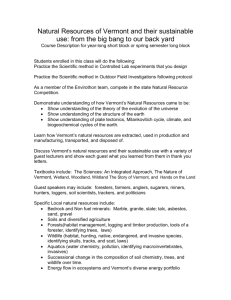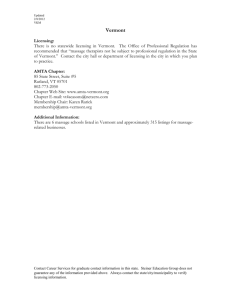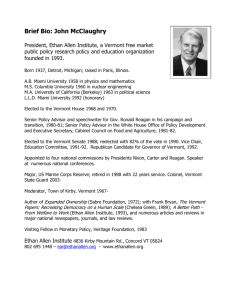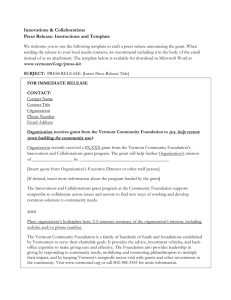ECONOMIC GOALS AND POLICIES
advertisement
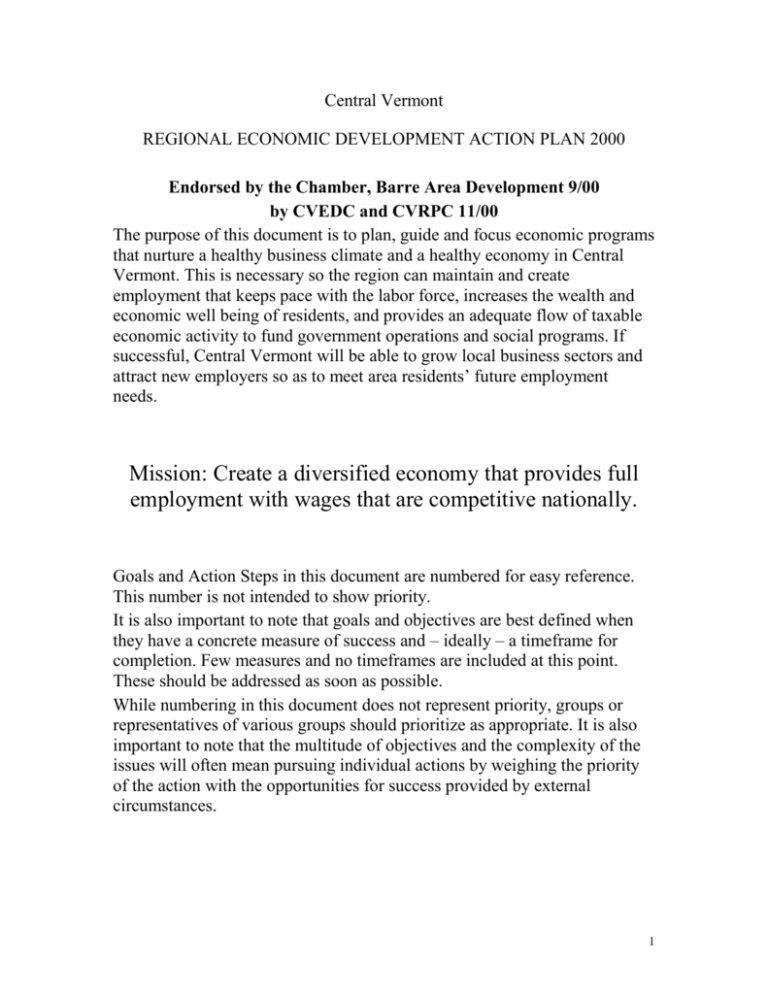
Central Vermont REGIONAL ECONOMIC DEVELOPMENT ACTION PLAN 2000 Endorsed by the Chamber, Barre Area Development 9/00 by CVEDC and CVRPC 11/00 The purpose of this document is to plan, guide and focus economic programs that nurture a healthy business climate and a healthy economy in Central Vermont. This is necessary so the region can maintain and create employment that keeps pace with the labor force, increases the wealth and economic well being of residents, and provides an adequate flow of taxable economic activity to fund government operations and social programs. If successful, Central Vermont will be able to grow local business sectors and attract new employers so as to meet area residents’ future employment needs. Mission: Create a diversified economy that provides full employment with wages that are competitive nationally. Goals and Action Steps in this document are numbered for easy reference. This number is not intended to show priority. It is also important to note that goals and objectives are best defined when they have a concrete measure of success and – ideally – a timeframe for completion. Few measures and no timeframes are included at this point. These should be addressed as soon as possible. While numbering in this document does not represent priority, groups or representatives of various groups should prioritize as appropriate. It is also important to note that the multitude of objectives and the complexity of the issues will often mean pursuing individual actions by weighing the priority of the action with the opportunities for success provided by external circumstances. 1 Goal I: Generate broad-based support for the Regional Economic Development Action Plan as a useful planning and implementation guide. Discussion: The region’s economic health cannot be the exclusive domain of any group or organization. It provides employment for 30,000 residents and the food, shelter and family needs for 60,000 residents. Local and state taxation of this commerce finances education, social programs and environmental protection. Businesses, employees, municipalities, development and community organizations must work together to ensure a vital economy that can attract investors, encourage success, and provide residents with rewarding career opportunities and access to the region’s exceptional quality of life. To encourage wide spread participation and cooperation without impinging on organizational autonomy or creating excessive bureaucracy, the region offers this Regional Economic Development Action Plan as a guide which Central Vermont’s organizations, municipalities and individuals can reference when establishing their own goals and programs. One objective of this plan is to have it widely endorsed and supported by a broad-based constituency. Accomplishing the objectives of the plan, however, requires more than mere endorsement. Objectives will not be met simply because people want them. Therefore, another objective is to identify the groups, municipalities, individuals and organizations most interested, and to facilitate better communication and coordination among these parties, especially as their actions relate to the objectives of the plan. The Regional Economic Development Action Plan is not intended to superceded or conflict with the Central Vermont Regional Plan. In fact, it is intended to complement the Regional Plan’s Economic Element. The Regional Economic Development Action Plan supports sound planning at all levels. It recognizes the importance of advocating economic issues in the planning process. While economic advocates must make their concerns known to planners, they also need to recognize that economic health is not the sole focus of sound planning. Economic vitality is fundamental to quality of life, but it does not represent quality of life in and of itself. 2 Action Steps: 1. Seek endorsement of the Regional Economic Development Action Plan by municipalities and a broad range of community organizations. 2. Determine the best method(s) of communication among the most interested parties and facilitate an ongoing process of communication, monitoring and measuring success. 3. Meet with selectmen, planners, state officials and legislators to discuss economic issues. 4. Establish specific lines of communication with state, regional and local planning and development bodies. 5. Identify and promote specific economic provisions in town plans. 6. Provide input and comment on town plans; encourage inclusion of economic elements. Goal II: Build On What’s Here (Addressing Fundamentals) Discussion: A large or well-known company relocating to a community makes headlines; however, expansions by existing companies usually create more jobs. While newcomers are important, employers already here are critical. Fortunately, the fundamental requirements for both are the same – a supportive business climate, sensible tax policy, sound infrastructure, places to expand, and financial and technical assistance. In order to assess the region’s ability to serve and support existing employers, it is important to identify major employment sectors and become familiar with their economic issues and special industry needs, if any. It may also be useful to identify the special needs of smaller, faster-growing industry sectors. Action Steps: 1. Hold regular forums/focus groups for discussion of key economic issues for - and obstacles to -maintaining a strong commercial/industrial climate. 2. Support the continuation and development of industry networks and information exchanges to more fully utilize the region's current capacity. 3. Identify obstacles faced by specific sectors, including both large and small employers. 4. Aggressively seek to reduce/eliminate unnecessary obstacles to prosperity and expansion. 3 Goal III: Have sufficient inventory of commercial and industrial sites to meet future business expansion and community employment needs. Discussion: A percentage of existing employers will grow significantly and require additional space. In a healthy economic climate the percentage increases. In most cases, these employers will first seek suitable space within close proximity to their existing site. If forced to look beyond a short commuting distance for current employees, the employer often has little reason not to look beyond the region or even beyond Vermont for a suitable site. One of the key advantages smaller businesses have over larger competitors is the ability to act quickly to take advantage of opportunities in the marketplace. A local business that needs to expand to grasp an opportunity may lose its advantage if it cannot expand rapidly enough. Time is also important to established firms seeking to relocate or expand. Once a decision is made, prompt action can thwart competitors with similar thoughts and/or ensure continuity among workers in existing plants. Therefore, it is imperative that the region has an ample supply of buildings and sites that can be occupant-ready in a short timeframe. They should be reasonably distributed around the region to best accommodate local expansions. Action Steps: 1. Assemble an inventory of existing buildings and permitted commercial and industrial sites. 2. Analyze their capacity to meet future employment needs – in size and number, geographic distribution, quality of infrastructure. 3. Encourage municipalities to identify and assist expansion of local industries – especially those that utilize the region's natural resources and raw materials or provide value-added processing of mineral, agricultural and forest products. 4. Support state and local policies that ensure the region’s resources and raw materials can be retrieved, processed and moved to market. 5. Evaluate the viability of existing and likely industrial/commercial sites based on infrastructure, soils, access, constraints, and compatibility with town planning and zoning. 6. Use existing GIS and other information to assess the development capacity of and for commercial and industrial sites in the Region. 4 7. Work with municipalities to find land that both the municipality and others agree would be suitable for commercial and industrial development or redevelopment. 8. Support continued identification, review and designation of growth centers by municipalities and the Regional Planning Commission; advocate special state consideration of such centers. 9. Assist municipalities in identifying and prioritizing the options available to them to meet current and desired future industrial/commercial site development needs. 10.Identify those types of end users that are most desired/acceptable. 11.Seek and support improvement of sites to help make them “market ready.” 12.Work with communities to update town plans and zoning maps to identify viable commercial/industrial areas and to include only those that actually have development potential (infrastructure, access, and limited constraints, etc.). Goal IV: Increase the County’s (Region’s) share of overall Vermont employment – especially manufacturing employment. Discussion: For several decades, Central Vermont has represented about 10 percent of Vermont in land area, population, housing, jobs, etc. However, the past two decades have seen Burlington and surrounding areas emerge as the primary focus of Vermont. Triggered by growth of its airport, recognition as a Standard Metropolitan Statistical Area, and the addition of several major employers and retailers, Burlington’s growth threatens to skew Vermont’s economic, social and political arena. In order to maintain its autonomy and its marketplace, Central Vermont must retain and increase its share of Vermont’s resource base. Doing so begins with those activities that generate community wealth. Manufacturing – including value-added processing – brings wealth to the region by exporting products to purchasers outside the region. One fundamental means of increasing community wealth is for local residents to receive payment for services consumed outside the region. Overall, manufacturing generally pays above average wages and better than average benefits. Community wealth bolsters retail trade and local services. Action Steps: 1. Identify the labor needs of area businesses and see that trained and qualified employees are available; establish training programs as 5 necessary to ensure manufacturers and others can employ local residents in their operations. 2. Assist towns in quantifying their residents’ future employment needs, and ask them to identify key employment sectors whether in town or nearby. 3. Identify the region's funding requirements to support employment growth, including the funds needed for infrastructure improvements. 4. Develop and disseminate information on development incentives, techniques and resources for towns and local development groups; create and distribute a manual/brochure of successful projects. 5. Seek and support expansion of programs to reclaim contaminated (“brownfield”) sites. 6. Foster cooperation among state agencies, municipalities, area development groups, banks, and citizens groups in the siting and permitting of development projects. 7. Provide support to help applicants through the permitting process: technical support, business participation in hearings, peer-to-peer, and/or permit review specialists. Coordinate contact with applicants, assist in review, and permit processes. 8. Maintain an inventory of available commercial buildings and permitted sites, and promote the reuse of vacant buildings or approved, permitted sites whenever possible. 9. Support and advocate the Vermont Economic Advancement Tax Incentives package. 10.Coordinate presentation teams for region and cities. 11.Produce development guide and resource manual. 12.Create industrial / commercial space available brochure. Goal V: Improve Regional Infrastructure & Capacity Discussion: Infrastructure is vital to both economic development and environmental protection. It is also an important means of guiding future growth and development to the most desired areas. The more willing communities, regions, and the state are to make public investments in infrastructure, the more they can encourage and control development patterns through nonregulatory means. Since infrastructure capacity is an important resource and expansion is capital intensive, it is vital that capacity be utilized efficiently. Toward this 6 end, capacity should not be consumed by excessive, schedule-based allocations, infiltration of groundwater, or artificial water quality management objectives. Action Steps: 1. Map the region’s infrastructure and service areas for water, sewer, power, and communications services among others. Include detailed distribution routes, capacities, and specifications wherever possible. 2. Determine and summarize available capacity for municipal water treatment and wastewater disposal systems to give developers and municipalities an idea of which areas can be developed and to what extent within the capacity of the current utilities. 3. Encourage and support inter-municipal cooperation - especially within adjoining growth areas - for sharing of water and wastewater capacity. 4. Reduce the flow of ground and storm water into treatment systems. 5. Advocate measuring actual water use where appropriate, rather than State estimating standards, for permitting and allocation. Formulas can inhibit appropriate development and tie up capacity unnecessarily. 6. Support rules and standards for on-site septic that reflect current technology for safe waste disposal. 7. Advocate approval of appropriate small-quantity wastewater treatment systems. 8. Advocate restructuring that will allow purchase of electrical power from competitive markets. 9. Develop and support policies that expand and enhance high-speed data transmission. 10.Advocate and support appropriate installation of new energy resources such as gas pipelines and co-generation facilities. 11.Promote the commercial and emergency value of wireless communication and the need for affordable full-coverage services. 12.Identify funds available to upgrade infrastructure, including improved commercial/industrial sites. 13.Seek to ensure that no unnecessary permit conditions are imposed on infrastructure extensions and improvements that become part of municipal systems; i.e., having all connections require additional Act 250 amendments. 7 14.Identify and promote infrastructure financing methods that share system costs with the general public and minimize the costs borne by users. 15.Encourage towns to identify and plan for future infrastructure improvements, extensions. Goal VI: Strengthen Downtowns and Growth Centers (Increase county share of Vermont retail market) Discussion: Downtowns are an integral part of our economic and social structure. They are important to our sense of place and history. As areas of concentrated business activity, they are key components of our economic health and attractive to visitors. Growth Centers represent a compromise between downtowns and rural sprawl. They are areas that have – or can be – built to higher densities than surrounding lands. They may be the result of historic settlement patterns and/or they may be emerging because of the availability of important infrastructure. These areas of concentration can be encouraged to host development, thereby minimizing the consumption of surrounding rural lands. Local, regional and state policies should support and encourage development in downtowns and growth centers. The Central Vermont Regional Planning Commission has been a statewide leader in identifying and supporting growth centers. To date, however, this effort has received very limited support from the State of Vermont outside of downtowns. This action plan applauds the regional effort and encourages its continuation. It urges the State of Vermont to become more supportive in this arena. Action Steps: 1. Support continued identification, review and designation of growth centers by municipalities and the Regional Planning Commission. 2. Advocate special state consideration of and support for such centers. 3. Assist municipalities in maintaining and strengthening city, village and growth center economies. 4. Seek to maintain downtown/growth center shares of retail sales, hospitality revenues and employment levels. 8 5. Expand the Downtown Bill and/or seek other programs to assist in development of important, economically prohibitive downtown buildings. 6. Assist downtown revitalization programs through marketing support and policy advocacy. 7. Support downtown incentives programs & assist cities, villages and employers seeking to qualify. 8. Seek incentives for growth center development and infrastructure improvements. 9. Work with municipalities to identify and preserve important, economically viable, historic structures. 10.Provide assistance to cities and towns expanding their commercial base. 11.Encourage towns that still tax inventory and/or machinery and equipment to eliminate these taxes. 12.Assist in maintaining and facilitating housing in commercial districts. 13.Support municipalities who seek payment in lieu of taxes as part of the approval for construction of State facilities 14.Encourage Community Reinvestment Act Banks to become even more active partners with the region’s downtowns and growth center communities. 15.Encourage revision in Labor & Industry Standards that make downtown revitalization prohibitively expensive. (Standards requiring that everyone be well served often mean no one is served because space cannot be renovated profitably; i.e., upper floor handicapped access.) 16.Conduct or encourage forums and workshops for local officials to share ideas and successful techniques for downtown development, business retention and attraction, organization and marketing. 17.Maintain inventory of available retail locations and make it readily available. 18.Maintain employment, retail sales, and rooms and meals taxes data by town and county so that trends can be seen and addressed. 19.Implement "Shop Locally" campaign to encourage residents to trade in their community and the region. 20.Promote shopping in the region – especially downtown – to visitors. 9 Goal VII: Hospitality & Tourism - (Increased share of travel market) Discussion: The hospitality industry is another wealth importer. The cash left by the visitor is “profitable” community revenue because the visitor demands few of the services residents require. The visitor requires no educational expenditure and places no demands on social services, two of the state’s largest expense categories. In addition, visitors spend far more per day than residents. Tourism contributes to Vermont’s quality of life by providing recreational and cultural opportunities that could not be sustained by residents alone, and the industry is a key advocate for maintaining Vermont’s natural beauty, wildlife habitat and environmental quality. Too often degraded for its “low wages,” hospitality actually offers a wide range of career opportunities. The jobs most often associated with the industry’s low wage image are usually part-time and supplemented by tips. The combination of wage and tips can, in fact, be quite substantial on an hourly basis. Central Vermont’s marketing plan involves reaching out to make potential visitors aware of Vermont vacation opportunities, responding to those who seek additional information, and providing the visitor already in the community as much information about things to see and do as possible. Hospitality currently rivals manufacturing for “Vermont’s largest industry” status. It will most likely assume the “largest industry” role over the course of the next two decades. Hospitality is an important component of the economy in commercial centers like Montpelier, Barre, Northfield and Waterbury. For the most part, it is the economy in Warren, Waitsfield, Fayston and Moretown. Action Steps: 1. Adopt and implement an annual regional Travel Marketing Plan. 2. Develop a long-range plan for outreach marketing, request fulfillment, and detailed information. 3. Fully utilize emerging technologies and the internet; maintain and expand central-vt.com, Vermont’s most comprehensive regional internet site. 4. Capitalize on the Vermont name and images. 5. Encourage expansion and marketing of the region's recreational offerings, including skiing, snowmobiling, biking, hiking, horseback riding, hunting and fishing. 10 6. Maintain and expand the number and quality of recreational venues like skating rinks, auditoriums and parks. 7. Emphasize expansion of activities / facilities that appeal to children. 8. Seek resolution to conflicts that arise between commercial recreation and other uses. 9. Work with municipalities to identify viable options for expanded commercial recreation. 10.Continue aggressive tourist promotion in print as well as the internet. 11.Seek highway signage that attracts visitors and guides them to area attractions. 12.Determine best locations and types of information centers for regionwide network. 13.Maintain and expand year-round, 7-day visitor information sites. 14.Promote the quality and quantity of the region’s arts venues and performances. 15.Translate travel information to digital database format for “kiosk” presentation and integration with state database project. 16.Add mapping capability to in-house and internet data. 17.Consider: Central reservations and Tourist Train opportunities. 18.Improve hospitality training in the public schools and through the Service Excellence series. 19.Work collaboratively; build cooperative programs between state agencies, chambers and local groups, and individual businesses. Recognize and overcome limited human and monetary resources. 20.Establish better regional identity – “Who/what are we?” 21.Identify target audience – determine best markets for promoting region’s assets to the most desired visitors. 22.Support and encourage special events that will attract visitors and expand local entertainment options. 23.Market cultural, historical, recreational and entertainment assets to residents as well as visitors. 24.Institute better measures of the success of marketing strategies and expenditures. 25.Make measuring outcomes part of marketing routine. 26.Find/create sources of credible data. 27.Use Central Vermont’s hospitality marketing to promote business investment in the region. 11 Goal VIII: Promote and enhance educational opportunities for residents of all ages and skill levels. Discussion: Technology is moving at warp speed. Many of today’s most rewarding career fields did not exist 20 years ago. Many of yesterday’s traditional careers have evaporated or changed dramatically; i.e., “secretary.” No one can afford to spend his youth “learning” and his adult life “doing.” Most adults will change positions six to 12 times after entering the labor force full time. Increasingly, learning is a lifelong pursuit. Improved skills pay dividends to both employer and worker. Skilled workers command higher wages and also produce more for employers. The route to both higher wages and a successful business base is a well-educated, highly skilled workforce. Action Steps: 1. Establish, collect and publicize both student and educational system achievement measures. 2. Assist schools in obtaining and appropriately utilizing emerging technologies. 3. Continuously assess and respond to the training needs of area businesses – large and small. 4. Assist small businesses that don't have human resource personnel available to participate extensively in these processes. 5. Publicize – as CVEDC is doing - the career opportunities available locally and the skills/education needed to achieve them. 6. Assist businesses in developing in-house and industry-based training programs. 7. Encourage job-specific training programs like Service Excellence Training. 8. Identify the resources that are available to meet business and training needs; SBDC, SBA, college and high school courses, among others. 9. Promote job training and other subsidized employment as costeffective educational programs. 10.Expand economic and career education in schools. 11.Assist schools in preparing students for local career opportunities. 12.Institutionalize School to Work initiatives in the curriculum. 13.Encourage business internships with high schools and colleges for both students and teachers. 12 14.Conduct regular standards achievement and needs assessments. 15.Encourage employer outreach to under-achieving workers, and the provision of survival skill training for low income earners/families. 16.Encourage collaboration by employers to address employee transportation issues. Goal IX: Improve the transportation system Discussion: Fluid movement of goods and materials is critical to a healthy economy. Access to job centers is vital to residential choice of employers. Vermont has been woefully negligent of its transportation infrastructure, and its rural character makes commuter transportation systems especially challenging. With many deficient highways and numerous dangerously deteriorated bridges, Vermont’s highway transportation system may soon inflict serious damage on the state’s economic health. Rail and air provide important connections for movement of goods outside the state. Unfortunately, Central Vermont’s rail and air services have historically received limited attention in regional transportation planning. Fortunately, CVEDC has helped promote recent improvements at the airport. Action Steps: 1. Advocate improvements in and appropriate use of all transportation modes including rail, air service, mass transit, road, bridge, pedestrian, bicycle, automobile, trucking, and parking. 2. Map and publicize the region’s deficient bridges and roads. 3. Develop a schedule for repair or replacement of deficient bridges. 4. Improve state management of projects pipeline (long delays in implementing approved projects). a) Utilize more private-sector, entrepreneurial planning in state transportation process. b) Evaluate the long-term cost of mass-transit vs alternatives. c) Restructure State transportation planning to include significant public input, real enforcement capacity, commitment to live up to agreements, and accountability of AOT. Rely heavily on regional Transportation Advisory Committee and other nonpolitical, bi-partisan advisory committees for AOT prioritization. d) Come to timely closure and initiate construction. 13 e) Expand the Local Transportation Facilities program and assist communities seeking to take greater advantage of it. 5. Explore feasibility of east/west highway options. 6. Support freight rail and appropriate passenger service improvements, and encourage economic utilization of existing rail assets. 7. Investigate local and statewide tourist and passenger train potentials. 8. Preserve and improve service at E.F. Knapp and Burlington airports. 9. Participate in airport assessment, classification & prioritization programs. 10.Complete the regional recreation and bike path. 11.Maintain sensible policies regarding extra-long trailer trucks and the conflicting goals of “main street” economy and limited downtown truck traffic. 12.Improve parking in downtown and growth center areas. Goal X: Improve Permit Processes Discussion: Development permits provide an invaluable service by ensuring that development occurs in accordance with environmental safeguards and public policy. 1. State laws should be reviewed and revised to respect local decisionmaking to the maximum extent possible consistent with sound environmental planning. 2. Encourage adoption of a state culture of customer service - “permit applicant as customer approach.” 3. Encourage and support changes in law that allow communities to broaden the scope of local development review and that increase the influence accorded local and regional findings in State permit processes. 4. Eliminate redundancy in the presentation of materials by applicants – local review, district commission, Environmental Board if appealed. 5. Assist in the creation or modification of town ordinances, policies and procedures that will provide Central Vermont’s towns with increased influence in State permit processes; i.e., implementation of development review boards. 14 6. Actively present and advocate regional issues in permit processes at all levels of review. 7. Help developers understand that they need to request sufficient time in order to meet their construction and leasing schedules – for permit implementation. Requests for extensions should be made during the permit process – not after a permit has been issued. 8. Seek to improve the general knowledge of applicants and to provide more affordable assistance. 9. Seek appointment of people to District Commissions and the Environmental Board who appreciate both environmental and economic concerns. 10.Encourage permit enforcement that is thorough, professional, fair and consistent. 11.Help educate the public that it should not take the “message” out on the “messenger”; i.e., code enforcement officers are charged with enforcement of rules made by others. 12.Encourage more training for enforcement officers, administrators, volunteer boards, and staff. 13.Seek consideration of actual water use - as opposed to State Standards - for allocation and permitting. 14.Encourage more frequent communication between the business and environmental communities outside the permitting process. 15.Provide in-house assistance on planning, zoning, and Act 250 permits 16. Streamline the Act 250 Review Process: a) Preserve the non-expiration of permits (except serious violators). b) Shift the burden of proof – by clear & convincing evidence – to the appellant. c) Increase the weight accorded state permits; presumptions should be overturned only by clear and convincing evidence. d) Limit appeals to the applicant, adjoiners, and those representing public bodies; interested parties and special interests should be heard, but only public bodies and those directly affected should be able to initiate an appeal. e) Connections to infrastructure extensions not under the control of the applicant should not be subject to ongoing Act 250 jurisdiction. f) Designs by an appropriately licensed professionals should be accorded greater weight in permitting, and licenses should be sternly scrutinized. 15 Goal XI: Collect, Produce and Distribute Quality Data Discussion: Good decisions demand good data. State data is sparse, frequently confusing, and sometimes contradictory. There are no standard geographical reporting units for state data; county data is the most common boundary available. Regional data is disbursed by a variety of organizations. There is little coordination and no consistency in its presentation. Central Vermont has demonstrated strong capacity to collect and analyze data, and it has excellent mapping capabilities. It can, and should, be a leader in producing quality data in attractive and useful formats. Keeping quality data over time allows the region to identify strengths and weaknesses. It points to issues that might otherwise go unnoticed. Obtaining consensus on what data should be collected and what the data indicates can be a powerful tool in gaining the collaboration of groups that might otherwise be reluctant to work together. Action Steps: 1. Determine and produce broadly endorsed Quality of Life Indicators. 2. Coordinate with State agencies to collect and distribute data avoiding unnecessary duplication. 3. Work with municipalities, businesses and others to determine which data is important to the region and identify ways in which such data can be collected and distributed on a regular basis. 4. Advocate strengthening of State data collection. 5. Store data digitally, present it visually (charts and maps), and seek to avoid duplication in data collection and storage. Goal XII: Increase Access To Business Financing and Technical Assistance Discussion: Expansion of economic activity depends on the availability of capital for investment, loans for implementation, and management of both for success. Central Vermont has limited venture capital available. Most business endeavors are financed by equity in an existing business or the personal assets of the key stakeholders. The vast majority of loans come from 16 traditional financial institutions that are increasingly governed by decisionmakers that are distanced from the region or even the state. As a result, Vermont, which has historically been far more entrepreneurial than other states, faces significant challenges. It is likely that Vermont will see a shift toward larger employers and slower growth of small businesses. There are, however, mechanisms in place to enhance the availability of financing. For larger and mid-sized businesses, the Vermont Economic Development Authority and SBA 504 programs can be attractive sources. Medium and smaller businesses can often tap alternative lenders whose mission is to promote a particular type of activity or enterprise. Regional and community loan funds are also available. It is important to make these sources better known. Technical assistance is focused primarily at smaller firms and available from a variety of sources, many of which are under-utilized. In order to strengthen the region’s financial resources and increase access to these resources: Action Steps: 1. Encourage institutional lenders to keep decision-making at the most local level possible. 2. Encourage financial institutions to partner with alternative lenders. 3. Package and market information about lenders and venture capital sources of all types. 4. Support continued capitalization of VEDA program for below-market interest rates. 5. Publicize tax credits, stabilization and other components of the project financing mix. 6. Coordinate and market business workshops, seminars, and technical assistance providers. 7. Encourage participation and utilization of colleges in market research and business assistance. 8. Use emerging technologies and the web to promote and provide technical assistance. Goal XIII: Capitalize on GIS and Emerging Technologies - Think Digitally Discussion: The widespread use of computer technology over the past 10 years rivals the introduction of the telephone or the automobile as the most socially and 17 economically significant events of the Twentieth Century. It has dramatic implication for Vermont and our region. In many ways, the computer and the internet are “great equalizers.” Small businesses, small communities and small states have opportunities to compete effectively with larger counterparts. On the other hand, technology is moving so rapidly that those with limited resources are challenged to keep pace. How this balance will play out over time is impossible to predict. Map-based information may offer the most significant change in visual presentation of data since the spreadsheet or chart. Vermont is extremely well positioned to be a leader in map-based (GIS) information, and it must capitalize on this opportunity. By building on the opportunities of GIS and the internet while addressing the pitfalls, Central Vermont can help turn these emerging technologies to its strong advantage. The next generation of consumers/employees have grown up with the web. It will be their information gathering and communications foundation. Action Steps: 1. Think digitally! 2. Post public information on the web where all can obtain it. 3. Promote web presence; being on the web is like being in the phone book. 4. Promote telecommunications improvements and widespread use of new technologies. 5. Minimize telecommunications taxes to keep technology available to every resident. 6. Obtain and utilize state-of-the-art technology and equipment. 7. Seek to continue to upgrade regional GIS capabilities. 8. Regularly present information in GIS venues. 9. Move Central Vermont’s GIS capability to the world wide web. 10.Cross train regional staff on emerging technologies. 11.Develop interactive mapping capability. 12.Provide business incentives and assistance for using internet. 13.Conduct educational seminars with broad-based community involvement. 14.Educate the community on the costs/benefits of using technology. 15.Encourage information providers to underwrite/assist education programs. 16.Form technology and user alliances among business, government, educators and other users. 18 XIV: Advocate Sound Public Economic Policy Discussion: The economic environment in which all activity occurs is heavily defined by governmental policy. It is imperative that Central Vermont businesses, residents and municipalities make their needs and concerns known to government officials at all levels. The action steps in this arena must include both mechanisms for strong communication and emphasis on vital economic messages. Action Steps: 1) Meet with legislators and municipal officials to press the region’s economic agenda. 2) Communicate economic and program concerns to appropriate agency officials. 19

